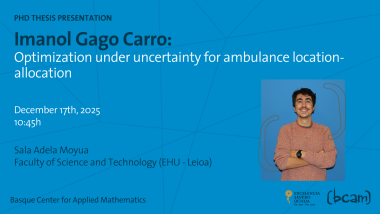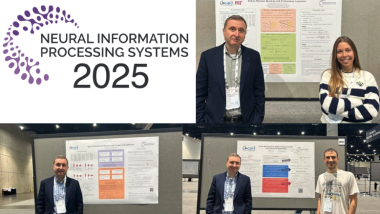Alejandra Hernández defenderá su tesis el lunes 21 de julio
María Alejandra Hernández Velandia ha sido doctoranda en el Basque Center for Applied Mathematics (BCAM) desde octubre de 2020, donde trabaja dentro del grupo de Applied Statistics. Su investigación se centra en el análisis de datos longitudinales utilizando modelos semiparamétricos y no paramétricos, particularmente mediante el uso de P-splines y modelos de efectos mixtos. Su objetivo es mejorar el ajuste de curvas y la estimación de derivadas. La aplicación principal de estas metodologías es el estudio del crecimiento de la estatura humana durante la adolescencia.
Hernández obtuvo su grado en Matemáticas en la Universidad Nacional de Colombia en 2016, seguido de una maestría en Estadística en la misma universidad en 2018. Más recientemente, en 2020, obtuvo su especialización en Ciencia Actuarial en la Universidad Antonio Nariño.
Su tesis, titulada “Novel P-Spline-based Approaches for Curve and Derivative Estimation in Longitudinal Growth Studies”, está dirigida por el Dr. Dae-Jin Lee (IE University) y la Dra. María Xosé Rodríguez Álvarez (Universidade de Vigo). Defenderá el 21 de julio de 2025, en la Sala Adela Moyua, en la Facultad de Ciencia y Tecnología del campus de Leioa de la EHU, a las 11:00 a.m.
En nombre de todos los miembros de BCAM, le deseamos lo mejor en su futuro, tanto profesional como personal.
Abstract
Longitudinal data analysis plays a key role in understanding individual development over time. It helps identify important characteristics such as growth patterns, biological variations, and key milestones like growth spurts and the age at which they occur. Although several statistical models and software implementations are available to estimate growth curves and their derivatives, challenges remain due to the complex and dynamic nature of these processes.
This dissertation explores a range of statistical methods for modeling growth based on repeated measurements from individuals. In particular, it highlights the use of penalized spline (P-spline) models, which have gained popularity for their flexibility in modeling smooth curves. Additionally, their connection with mixed-effects models allows us to take advantage of the methodological and computational tools in this setting for fitting P-spline models.
We focus on three main classes of models for fitting individual growth trajectories and estimating their derivatives: (i) the double-penalty P-spline model, (ii) a family of semiparametric mixed-effects models, and (iii) modified versions of the SuperImposition by Translation and Rotation (SITAR) model. Each approach is discussed in terms of its theoretical background, practical implementation, and suitability for growth analysis.
The proposed methods are evaluated through simulation studies and compared with alternative approaches to assess their performance. Our results indicate that the proposed models provide a slight improvement in curve fitting and derivative estimation. Additionally, we demonstrate the application of these methods using real longitudinal data from 125 young professional football players to analyze their growth and maturation processes over time.
Related news
La gente del BCAM
Mujeres en la ciencia




